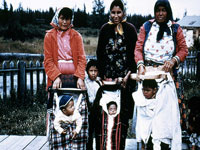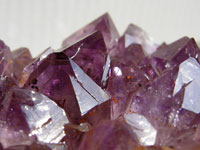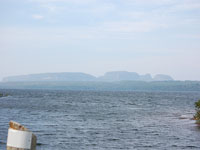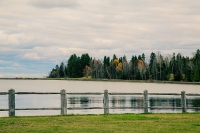Thunder Bay Travel Guide
Thunder Bay is in the heart of First Nations land and is located on the Trans-Canada Highway, serving as the western terminus for the St Lawrence Seaway. The seaway is the system of locks, channels and canals that connect the Great Lakes to the Atlantic Ocean. Along with being an important system of waterways for international trade, it's a playground for recreational boating activities.
This rugged, northern region is home to Lake Superior, the largest of North America's Great Lakes and a hugely popular attraction. Visitors travel to this vast expanse of water to enjoy its striking shoreline and surrounding wilderness. Nature-lovers will relish immersing themselves in Thunder Bay's lakes and rivers, wandering its forests, and exploring its deep chasms, plunging waterfalls and towering granite cliffs.
Things to do in Thunder Bay
Ontario boasts about 330 parks, attracting more than 10 million visitors annually. Many of these picturesque areas are clustered near Thunder Bay and around the massive Lake Superior, offering travellers a number of exciting opportunities for outdoor recreation. Lake Nipigon and the township of the same name are close to Thunder Bay, and are also a hub for outdoor pursuits such as hiking, camping and water sports.
The region has some cultural diversions too. The Amethyst Mine Panorama is a huge favourite, allowing visitors the chance to poke around for souvenirs in one of the largest amethyst deposits in the world. The Fort William Historical Park is a living history attraction that recreates the days of the North West Company and the Canadian fur trade, while the Magnus Theatre is the premium performance venue.

Fort William Historical Park
Visitors can travel back to 1816 at Fort William Historical Park, an authentic duplicate of the North West Company's inland headquarters. Located at Thunder Bay, this company was a major player in the fur trade, once a massive industry and an indelible part of Canada's colourful past. The fort brings this history to life through recreations of the characters, sounds, sights and smells that would have existed almost two centuries ago. The sprawling 250-acre site contains more than 57 heritage structures and more modern buildings, which visitors are free to explore. Visitors can also enjoy overnight experiences, education programmes, artisan workshops, conferences, banquets and festivals.

Amethyst Mine
Amethyst is Ontario's official gemstone, and is just one of the many natural gifts unearthed on the north shore of Lake Superior. The semi-precious stones native to this area come in various beautiful shades, such as Precious Purple and Thunder Bay Lavender. Visitors can mine their own at the Panorama Mine, 35 miles (56km) east of Thunder Bay, which contains the largest amethyst deposit in Canada. All visitors need is a bucket and spade to enjoy a fun mining experience.

Sleeping Giant Provincial Park
Sleeping Giant Provincial Park is set on a rugged peninsula near Thunder Bay, where keen hikers can tackle trails running to the tops of granite cliffs and opening onto spectacular views of Lake Superior. These excursions aren't reserved just for sunny weather; winter travellers explore these routes on skis or snowshoes. The park also supports an exceptional mix of plant life, with two rare orchids, the Adder's Mouth and the Striped Orchid, growing in its southern parts. In fact, 24 types of orchid grow in the park, as do ferns, while wildlife includes more than 200 species of bird, white-tailed deer, red foxes, porcupines, moose, bears, wolves and lynx.

Lake Superior
Lake Superior is the largest of the Great Lakes of North America, and the biggest freshwater lake by surface area in the world. Ontario shares this vast expanse of water with the American states of Minnesota, Wisconsin and Michigan. The lake's rugged shoreline and beautiful wilderness landscapes make for great hiking, while the lake itself presents endless opportunities for all manner of watersports, fishing and boating.
Getting Around
Thunder Bay has a large fleet of fully wheelchair accessible buses that service the city and surrounds. The local council has also transformed the city into a pleasant place to walk or bike, meaning locals and visitors can enjoy an extensive network of cycle lanes, recreational trails, wide sidewalks and active living corridors. Taxi services are available and drivers will find ample parking.
Thunder Bay Climate and Weather
Thunder Bay's humid continental climate produces hot summers and cold winters. However, Lake Superior influences conditions and gives the city cooler summers and warmer winters than other places in the region.
The best time to visit is from June to September, when temperatures are warmer. The average high temperature in summer is around 73.4°F (23°C). The hottest month is July, while January is the coldest, when temperatures can dip to -2.2°F (-19°C). Winters can be bitterly cold for visitors not used to extreme temperatures.
Canada travel info
Electricity
Electrical current is 120 volts, 60Hz. American-style flat two-pin plugs and a plug with a third round grounding pin are standard.
Language
The official languages are English and French (spoken predominantly in Quebec).
Money
The currency used is the Canadian dollar (CAD). Banks and bureaux de change will change cash, as will some hotels. Major credit cards are widely accepted and ATMs are widespread. US dollars are widely accepted.
Tipping
A tip of around 15 percent is standard in restaurants, and hairdressers and taxi drivers are usually tipped at the same rate. Bellhops, doormen, porters, and similar service providers at hotels, airports, and stations are generally paid at the customer's discretion.
Health
Travellers should be up to date with your COVID-19 vaccines before traveling to Canada, and should consider taking routine vaccines as a standard precaution. Medical care is excellent but expensive, so medical insurance is advised.
Safety
While most visits to Canada are trouble-free, the country does share the common international risk of terrorism. The crime rate is low but travellers are advised to take sensible precautions to safeguard their belongings, as they would anywhere. Parts of Canada are prone to tornadoes between May and September.
Local customs
Rowdiness and loud speech are inappropriate except under special circumstances or in places such as bars, as Canadians tend to be soft spoken, patient and almost apologetic in their public behaviour. They are generally tolerant of the complex network of cultural differences in public behaviour, particularly in cities where such diversity is more common place. Recreational cannabis is legally available throughout Canada, though local laws can vary depending on the province or territory travellers are visiting.
Doing business
Vancouver, Toronto, Calgary, and Montreal are the main business centres, and English is the language of business except in French-speaking Quebec, where all written material and business cards should be in French. Business cards are not traditionally exchanged during an initial meeting, but at some appropriate time thereafter; it is best to wait for the host to offer theirs first.
A firm handshake is used by way of greeting and punctuality should be taken seriously for meetings. Canadians dress conservatively and smartly for business and suits are the norm. Gifts can be given in conclusion to celebrate a deal, but should be understated; taking someone out for a meal is a popular way to conclude business dealings.
Canadians are reserved and frown on emotional outbursts. Business is based on facts and figures rather than relationships, so it is best to be as prepared as possible for meetings. Hours of business are usually 9am to 5pm, Monday to Friday.
Duty free
Travellers to Canada are allowed to enter the country with the following items without incurring custom duties: gifts to the value of C$60 per recipient (excluding advertising material, tobacco and alcoholic beverages); 200 cigarettes, 50 cigars or cigarillos and 200g of tobacco or 200 tobacco sticks; 1.14 litres of liquor or wine or 24 x 355ml bottles or cans of beer or ale. There are strict regulations governing the import of the following: explosives, endangered animal and plant species, items of heritage, fresh foodstuffs and weapons.
Communications
The international access code for Canada is +1. The outgoing code is 011 followed by the relevant country code. The outgoing code is not necessary for calls to the US and the Caribbean. Hotels, cafes and restaurants offering free WiFi are widely available. As international roaming costs can be high, purchasing a local prepaid SIM card can be a cheaper option.
Passport & Visa
All visitors must hold a valid passport, and it's recommended that passports always be valid for six months after the intended period of travel. Visitors are required to hold onward or return tickets, all documents needed for the next destination and sufficient funds to cover the period of intended stay.
Travellers from most visa-exempt countries arriving in Canada by air need to fill in an Electronic Travel Authorisation (eTA) form online prior to visiting Canada. This requirement is applicable to all but U.S citizens and travellers with a valid Canadian visa. Canadian citizens, including dual citizens, and Canadian permanent residents cannot apply for an eTA. As part of the Western Hemisphere Travel Initiative (WHTI), all travellers travelling between the United States and Canada, Mexico, Bermuda, and the Caribbean region are required to present a passport or other valid travel documents to enter or re-enter the United States. If departing from the USA a valid passport will be required by immigration authorities.
Entry requirements
US travellers should have a valid passport if departing from the USA. Other proof of citizenship is accepted in the form of a birth certificate, a US certificate of citizenship, a US certificate of naturalisation, or a NEXUS card. A visa is not required for a stay of up to six months.
UK nationals must have a passport valid for the period of intended stay. A visa is not required for a stay of up to six months, though UK travellers must have Electronic Travel Authorisation (eTA).
Australians must hold passports valid for period of intended stay. Nationals of Australia with an Electronic Travel Authorisation (eTA) are visa exempt for a maximum stay of 6 months.
South African nationals must be in possession of a passport valid for the period of intended stay. A visa is required. South African temporary passports are not recognised. Passports, identity or travel documents of Bophuthatswana, Ciskei, Transkei and Venda are not accepted.
Irish nationals must hold a passport valid for the period of intended stay. A visa is not required for stays of up to six months. However, the individual must have an Electronic Travel Authorisation (eTA).
New Zealanders require a passport valid for the period of the intended stay. No visa is required for stays of up to 6 months. However, the traveller requires an Electronic Travel Authorisation (eTA).
Useful contacts
Canadian Tourism Commission, Vancouver: +1 604 638 8300 or www.travelcanada.ca
911 (all emergencies)Embassies / consulates in other countries
Canadian Embassy, Washington DC, United States: +1 202 682 1740.
Canadian High Commission, London, United Kingdom: +44 (0)20 7258 6600.
Canadian High Commission, Canberra, Australia: +61 (0)2 6270-4000.
Canadian High Commission, Pretoria, South Africa: +27 (0)12 422 3000.
Canadian Embassy, Dublin, Ireland: +353 (0)1 234 4000.
Canadian High Commission, Wellington, New Zealand: +64 (0)4 473 9577.
Embassies / consulates in Canada
United States Embassy, Ottawa: +1 613 688 5335.
British High Commission, Ottawa: +1 613 237 1530.
Australian High Commission, Ottawa: +1 613 236 0841.
South African High Commission, Ottawa: +1 613 744 0330.
Irish Embassy, Ottawa: +1 613 233 6281.
New Zealand High Commission, Ottawa: +1 613 238 5991.



